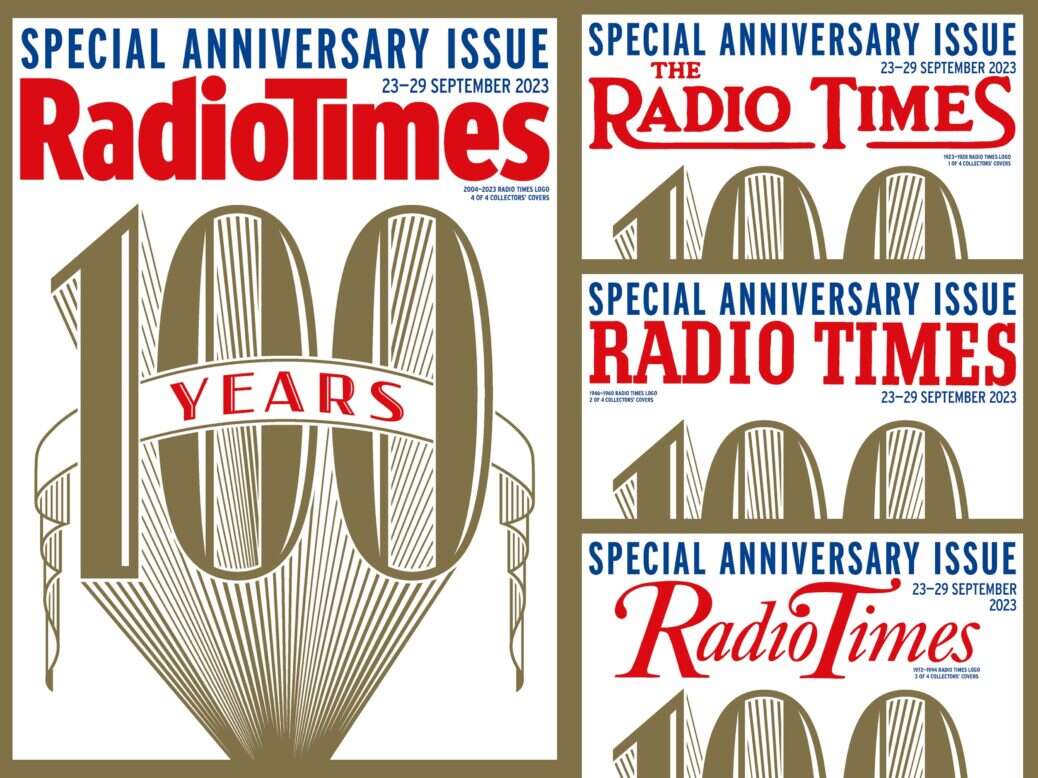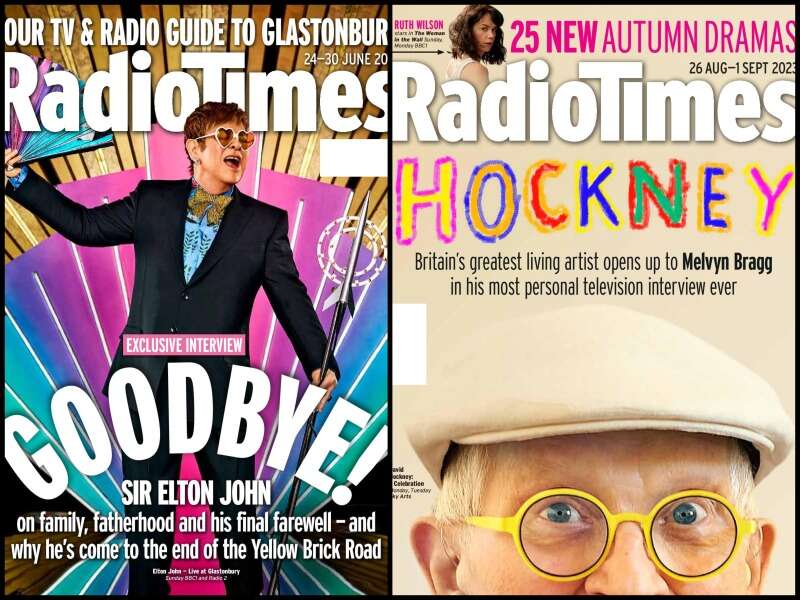
One hundred years on, the Radio Times print magazine continues to be the highly profitable “mothership” of the brand, its joint editor Tom Loxley has told Press Gazette.
Radio Times is the biggest revenue-generating title at Immediate Media, which has owned the TV, film and radio magazine since 2011 after the BBC sold its magazines division to Exponent Private Equity. Immediate Media was in turn bought by German publisher Hubert Burda Media in 2017.
Thursday 28 September marks the centenary of the first Radio Times issue hitting the newsstands. It was founded by Lord Reith, BBC managing director and later its first director-general, as a listings magazine and the “official organ” of the corporation that would help people understand what they were paying for through the new licence fee after its radio services began. Starting with six radio stations, it now carries listings for 86 TV channels and 63 radio stations.
Today (Tuesday 18 September) the Radio Times celebrates the centenary in its new issue. It has four commemorative covers designed by Peter Horridge, who created the emblem for the Coronation of King Charles III, and each cover features a different masthead from its history: the original design from 1923, the post-war logo used between 1946 and 1960, the longest-running logo of 1972 to 1994, and the current logo, introduced in 2004. Inside, the issue names the 100 most memorable radio and TV programmes of the last 100 years.
Former executive editor Loxley, who has joint-edited the magazine since the start of 2020 alongside former deputy editor and art director Shem Law, told Press Gazette: “It’s a behemoth, a big beast in the publishing world when it comes to not just its heritage, its history and its importance over 100 years, but also the fact that it’s still highly profitable.”
As well as the magazine, the Radio Times magazine now encompasses a 26-year-old website that claims to reach 20 million people per month, an app and a weekly podcast that has had 1.25 million downloads. Each format is crucial for adapting to changing habits, Loxley said – but he added that the print title “remains the mothership… everything we do spins out of that magazine”.
“All of those iterations of Radio Times that aren’t a magazine wouldn’t exist without the magazine. We’re here making it week in, week out not just because we love it and not just because it’s a brilliant showcase for everything that Radio Times does in all its forms – we also do it because it makes money.” The Radio Times website in addition first hit profit in 2013.
Somewhat unusually, the Radio Times editorial teams for the magazine (45 people) and website (15 staff) are still separate operations – although they do share some content. For example, the magazine team’s recommendations are used on the website while sometimes the online team will be able to conduct and publish an interview that needs to be published more quickly than the print schedule allows.
The two teams also have slightly different audiences and aims, Loxley explained. Radio Times magazine readers have an average age of 62, while the average online reader is 52, according to TGI consumer data shared by Immediate Media. Around 50% of print readers also use the website.
[Read more: Boosting soaps and gaming coverage helps century-old Radio Times stay relevant]
The magazine helps people plan their entertainment a week in advance, whereas the website is “all about there here and now” of what’s on and entertainment news – meaning there is no “clash” between them, Loxley said. The website takes a broader look at entertainment, having expanded into areas like gaming which do not feature in the magazine.
Radio Times subscriber base strong 100 years on
The majority of revenue at Radio Times magazine comes from subscriptions and newsstand sales. In recent years, accelerated by the Covid-19 pandemic, the title has seen a massive shift in the balance towards subscriptions.
In the second half of 2019, 46% (242,415) of Radio Times’ circulation came from subscriptions. Subscriptions made up more than half of its circulation for the first time in the first half of 2020, and by 2022 that figure was at 61% (261,330 subscriptions). It is now on 253,000, according to Immediate Media, which claimed this is the highest subscriber figure for any weekly magazine in the UK.
Although the total Radio Times circulation fell by 36% between 2016 and 2022, newsstand sales fell much more steeply (by 58%) than subscriptions, which were down by 2%.
Loxley told Press Gazette: "I think everyone knows that the newsstand is a tough place to be right now. There's not a print publication out there that doesn't know that. If you've got a really strong relationship with your readers, and they really value you, they will subscribe to you - and in our case, with some of our readers they broke the habit of a lifetime and subscribed to us," he said, referring to the start of the Covid-19 pandemic when it was more difficult for many to make a quick trip to the shop.
"That subscription is quite an investment on their part," Loxley continued. "The magazine costs £4 an issue, it's a quality magazine, you've got to pay for it. People want to subscribe, they want to make sure they don't miss an issue. They want to make sure that that relationship that we've got with them is kind of formalised in a subscription. You no longer have occasional readers, you have committed, every-week readers.
"And I've always thought the very best magazines are ones where the readers and the editors all feel like it feels like you're all in it together. You're operating at a kind of unspoken level where you both realise what each other wants from this and it feels like you're in the same kind of club, gang whatever. And our readers have an incredible sense of ownership for this magazine," he said, explaining that this is a legacy from its former BBC days.
[How to keep subscribers: What’s working at Hearst, Immediate and Mark Allen Group]
Other TV magazines today have higher circulations - but none have such a strong subscriber base. Bauer's TV Choice is the biggest by circulation on 972,869 in 2022, with What's On TV behind on 586,130 - but both rely entirely on newsstand sales, according to ABC. TV Times, with a circulation of 95,487, relies on subscriptions for a quarter of its sales.
Having a higher proportion of subscribers provides editorial freedom to be more creative than if you had to entice readers in each week in the shops, Loxley said.
For example, this year some popular Radio Times covers, according to Loxley, have included Sir Elton John ahead of his Glastonbury performance, Pet Shop Boys ahead of a BBC Two programme that looked back at their career, George Michael to coincide with a Channel 4 documentary about how he was outed, and the women's football World Cup and Rugby World Cup.
"But you can’t have one of those events every week of the year," Loxley said, "and there are occasions when it's a quiet week in TV and you really want to say something about your magazine and the people who read it and you want to take a risk. Back in the day if all of your sales were on the newsstand, you'd maybe think twice about doing something [more creative]."
He pointed, for example, at the August cover hooked on a Sky Arts documentary about the artist David Hockney. "We created one of the most striking covers that we've created this year that I think really encapsulates a lot of what the Radio Times is about.

"That is the kind of cover that with 61% of your readers subscribing you can happily do because you know that in a quiet week, it'll do just fine on the newsstand but it will also say an awful lot about what the magazine is - which is, in this case, cultured, intelligent, interesting, eye-catching, and that cover certainly was.
"So much as we'd like to have a special event every single week and make every cover feel like that, when you're a weekly magazine covering the world and TV and radio there's not a Bridgerton every week of the year."
For that, and many other reasons, Loxley said of subscribers: "They're your loyal readers and you hold them tight."
Radio Times readers 'can trust us'
Although the overall readership has gone down, Loxley said the aim is to "hang on" to that print audience "as best you can for as long as you can".
He said the key to continuing the long life of a 100-year-old magazine is "you've got to continue to adapt - but your core purpose remains and in our case it remains the same as it has been for 100 years". Titles like Radio Times particularly have to adapt because the industry they cover has changed so much, Loxley pointed out - for example, the magazine added a streaming section last year.
Its purpose goes beyond being a listings magazine, he added - it is all about offering guidance and always has been. "Our role hasn't changed in a sense, although the magazine has. We're there to guide readers to what's worth watching, what's worth listening to, and we give them a shortcut to the very best of entertainment in the broadest sense of that word."

The editorial team's aim is that they have genuinely watched everything they recommend in the "choices" section of the magazine so that "we're really giving people the benefit of our expertise and living up to our relationship - I think they think of us as a kind of candid friend," Loxley explained. "We are the people who will tell them what is worth watching, what is worth listening to and they can trust us."
Loxley previously told Press Gazette the Covid-19 pandemic had showed “the nation needs television like it’s rarely needed it before and to get the most out of that you kind of need Radio Times too”. He also described the magazine as a “crucial fourth emergency service”.
Loxley now says "some people got a bit irritated" at his phrasing "but I wasn't meaning to make light. I'm just saying - look, the point is TV really matters and it really helped people through". Part of the magazine's centenary celebrations will also include the results from a survey of 21,000 people conducted with the University of Sussex’s psychology department about how TV makes people feel.
Loxley added: "My feeling is that TV really matters to people and Radio Times, because we're by far the most important, longest-running, widest-read quality television magazine, really matters to those people who read us."
Email pged@pressgazette.co.uk to point out mistakes, provide story tips or send in a letter for publication on our "Letters Page" blog
